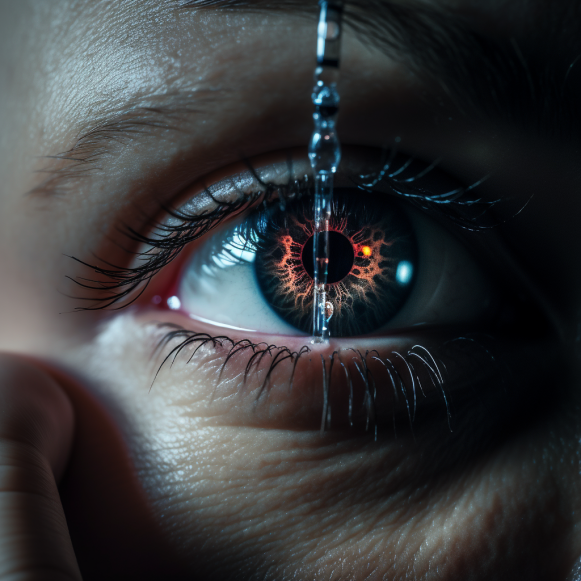Vision Impairments in Patients After COVID-19 Vaccination, Doctors Caution Possible Risks

In this series, we look at some of the lesser-known but common adverse events that are popping up in the research literature and doctors’ offices, as well as how to deal with them and reduce the risks.
Previously, on March 10, the Japanese government reported the first death attributed to the COVID-19 vaccine. 102 deaths have been officially documented by major countries since the COVID-19 vaccine rollout, including the United States, Canada, and the United Kingdom.
Mike Belcher, a Republican from New Hampshire, has been suffering from ocular migraines for nearly two years. In April 2021, he received his first Pfizer COVID-19 mRNA immunization, and things haven’t been the same since.
Belcher recalled developing severe flu symptoms about 12 hours after the shot. Neurological symptoms appeared within a few days.
His vision became strange, which was an unusual symptom. He began to notice a shift in the red and green color balance in his eyes, as well as the appearance of dark spots in his field of vision.
Belcher would soon be plagued by excruciating headaches, followed by a blinding light that would cause searing pain in the back of his eyes.
He also had more serious symptoms, such as impaired balance (he couldn’t walk in a straight line) and memory problems.
Belcher was finally hospitalized in May 2021 after being transferred from specialist to specialist.
“I was hospitalized for maybe four days, and I was discharged with the diagnosis of protracted ocular migraines with some other names stacked on,” Belcher said in an interview with The Epoch Times. “I had never had a migraine before, and at that point, I had a migraine for [about] 20-something days straight.”
Reports of Unusual Visual and Neurological Symptoms in the Vaccinated According to Alabama-based neurologist and neuroradiologist Dr. Diane Counce, she has seen many patients who, after vaccination, developed migraines or experienced a worsening or increased frequency of symptoms. These migraines would frequently cause temporary blindness.
Counce’s clinic has treated approximately 300 long-term and post-vaccine patients, and she has noticed that her long-term COVID patients have more understandable symptom presentations, a “more textbook presentation,” whereas patients who developed symptoms after vaccination may develop more severe and unexplainable symptoms.
Vision fluctuation, which was accompanied by other neurological problems, was a perplexing symptom she observed in her vaccinated patients. The patients’ visual acuity would deteriorate, but it would vary from day to day, with no obvious physical abnormality in the eye.
Patients find it difficult to change their eyeglass prescription due to the constant changes in symptom severity, “because they’ll be different the next day,” according to Counce.
Dr. Lynnell Lowry of the Alamo Eye Institute in Texas has also noticed an increase in unusual eye problems.
She told The Epoch Times about a patient who had her field of vision disrupted by snow-like disturbances for several weeks, but Lowry couldn’t find anything unusual upon examination.
The majority of Lowry’s vaccinated patients appeared to have developed vision problems as a result of shingles flare-ups or thyroid deficiencies.
She has also noticed an increase in rarer ocular issues. She would typically see central serous retinopathies once every five years, but in 2022, she has seen three cases in vaccinated people. She normally sees one case of cranial nerve palsy every two years, but in 2022, she has seen three cases in vaccinated people.
Eye Complications Documented in Literature and Database
According to data from the Centers for Disease Control and Prevention’s (CDC) Vaccine Adverse Event Reporting System (VAERS), approximately 70% of COVID-19 vaccine-related eye pain, blurry vision, and visual impairment reports, as well as more than 50% of all eye swelling reports, were filed.
While VAERS cannot determine whether an adverse event was caused by a vaccination, patterns in reporting may indicate the need for additional research to assess potential safety concerns.
The United Kingdom, which introduced vaccines around the same time as the United States, reported more than 9,000 cases of neurological symptoms to its VAERS database by late April 2021, including muscle spasms, myalgia, paresthesia, headaches, and dizziness.
A New Zealand study of approximately 3,000 vaccinated patients who developed uveitis prior to vaccine rollouts discovered that patients had an increased risk of uveitis flare-ups after vaccination.
Uveitis flares occurred at a rate of 12.3 per thousand patient months at the outset. This number increased to 20.7 following the first dose, 15 following the second dose, 12.8 following the third dose, and 23.9 following the fourth dose.
The American Academy of Ophthalmology published a review of ocular manifestations post-vaccine reported in the literature in November 2022. There were four types of eye complications:
When the tissues in the eye become red, swollen, and painful, this is a sign of an inflammatory disease. Inflammation in the conjunctiva, the outermost layer of the eye, and the sclera, the white layer covering the eye, as well as inflammation in the inner layers, including the episclera and uvea, has been documented following vaccination.
Optic neuropathies develop when the optic nerves that carry visual information from the eye to the brain are damaged. This can happen when blood clots block or limit blood flow to the nerves, or when the body begins attacking its own optic nerves, resulting in flashing lights in the eyes, vision loss, and pain.
Anterior segment conditions are linked to problems with the cornea, irises, and lens, as well as the muscles that control these areas. There have been several reports of keratitis, or inflammation of the cornea, since the vaccines were introduced. Reports of corneal transplant rejections have also been documented, though the rates of reporting are not higher than rates for other vaccines. Shingles-related eye infections have also been reported, and they can occur with or without rashes.
Tearing and retinal detachment are examples of retinal conditions. Because the retina detects light and color, damage to it can cause vision impairment and loss.
Within two weeks of receiving his first Pfizer vaccine dose, Mark from California noticed floaters in cobweb-like formations in his left eye. This occurred after experiencing chest pain within hours of receiving the vaccination.
His retina was bleeding, according to an eye specialist referral. His left eye’s gel, which gives eyes their spherical shape, was pulling on the retina, causing it to bleed. If the gel tears or causes the retina to detach, permanent vision loss may result.
More evidence is required to establish causation.
Doctors have become more cautious when discussing vaccine adverse events since COVID-19.
Mark claims that his ophthalmologist told him that the spike protein produced by his first dose of the COVID-19 vaccine may have aggregated in his eye, causing inflammation and damage, but other eye specialists disagree.
Mark had laser-assisted in situ keratomileusis (LASIK) to correct his vision more than 20 years ago, so other ophthalmologists told him he was at risk of retinal detachment from the start, despite the fact that studies have generally reported retinal detachment within the first few years after LASIK surgery.
While ophthalmologists are becoming more aware of vaccine side effects, some argue that the current evidence supporting vaccine-related ocular complications is insufficient.
Because ocular complications after vaccinations are uncommon to begin with, some experts believe it is unclear whether reported cases of suspected ocular problems after vaccinations are side effects or simply a coincidence.
Dr. Abdelrahman Elhusseiny, an ophthalmologist who has co-authored several studies documenting ocular adverse events following COVID-19 vaccinations, said that while the literature on this topic has grown since 2021, he has seen very few cases of possible vaccine adverse events in his clinic.
He also stated that many of his vaccinated patients who developed ocular problems had underlying health issues such as autoimmune disease, diabetes, or high blood pressure, which would predispose them to ocular symptoms and may increase the risk of vaccine adverse events.
While there is extensive evidence that COVID-19 vaccines can cause myocarditis, pericarditis, and thrombocytopenia, the evidence linking COVID-19 vaccines to ocular adverse events is quite weak.
“There is evidence, but it is not as strong as it is for other conditions, such as cardiovascular issues.” This is primarily due to [the] small number of events and a lack of well-controlled studies specifically on ocular adverse events,” ophthalmic epidemiologist and University of British Columbia professor Mahyar Etminan told The Epoch Times via email.
So far, the most convincing evidence comes from a Japanese epidemiology study that compared vaccinated and unvaccinated people. The authors discovered that the risks of ocular complications increased after the second dose after comparing approximately 80,000 double-dosed individuals to the same number of unvaccinated people. However, using a different technique to analyze the same sample revealed an insignificant link between vaccination and ocular symptoms.
There are several case studies that report possible links, but this type of study is less convincing as evidence to prove causality.
Nonetheless, Etminan believes it is possible to investigate the potential link between ocular complications and vaccinations, noting that the study should be well-designed and have a large sample size.
“Because these vaccines are being studied, we must be careful not to associate everything and the kitchen sink with these drugs.” This information should only come from well-designed studies, according to him.
Vaccine risks are now being discussed with patients by ophthalmologists.
To be on the safe side, some ophthalmologists are now actively discussing the vaccines’ potential risks with their patients.
Lowry stated that she now considers a person’s vaccination status and assesses its potential temporal association with the symptoms that her patients complain about.
Similarly, Elhusseiny stated that he informs his patients about the risks of vaccination so that they can make their own decisions.
One of Elhusseiny’s patients lost his spouse to COVID-19 and continued to be vaccinated without further adverse reactions, whereas another patient had a relative who had a vaccine-adverse event and thus decided not to be vaccinated.
Lowry emphasized the importance of doctors discussing vaccine risks with their patients.
After the COVID-19 pandemic, she noticed that while some patients suspect that the vaccines may have played a role in some of their symptoms, they are too afraid to speak up.
“There’s a huge stigma,” said Lowry. Patients who received vaccinations and experienced side effects are “almost afraid to blame it on the vaccine.”
Especially now that most people have had both vaccination and infection, doctors’ diagnoses have become more complicated, with Lowry comparing doctors to detectives.
Unresolved but Getting Better
The bright light causes his eyes to pulsate when he looks to the horizon, according to Belcher.
“The vision kind of fades in and out just a little bit,” he added. “That’s a constant feature.”
Belcher stated that many of the doctors he saw during and before his hospitalization were certain that the vaccine was a factor in his condition.
Fortunately for Belcher, the majority of his neurological symptoms are now under control.
Although his ocular migraines require daily medication to prevent relapses, he has noticed a decrease in frequency in recent weeks.
Belcher hopes that future tests will reveal the pathological causes of his ocular symptoms.

Reports of Unusual Visual and Neurological Symptoms in the Vaccinated
According to Alabama-based neurologist and neuroradiologist Dr. Diane Counce, she has seen many patients who, after vaccination, developed migraines or experienced a worsening or increased frequency of symptoms. These migraines would frequently cause temporary blindness.
Counce’s clinic has treated approximately 300 long-term and post-vaccine patients, and she has noticed that her long-term COVID patients have more understandable symptom presentations, a “more textbook presentation,” whereas patients who developed symptoms after vaccination may develop more severe and unexplainable symptoms.
Vision fluctuation, which was accompanied by other neurological problems, was a perplexing symptom she observed in her vaccinated patients. The patients’ visual acuity would deteriorate, but it would vary from day to day, with no obvious physical abnormality in the eye.
Patients find it difficult to change their eyeglass prescription due to the constant changes in symptom severity, “because they’ll be different the next day,” according to Counce.
Dr. Lynnell Lowry of the Alamo Eye Institute in Texas has also noticed an increase in unusual eye problems.
She told The Epoch Times about a patient who had her field of vision disrupted by snow-like disturbances for several weeks, but Lowry couldn’t find anything unusual upon examination.
The majority of Lowry’s vaccinated patients appeared to have developed vision problems as a result of shingles flare-ups or thyroid deficiencies.
She has also noticed an increase in rarer ocular issues. She would typically see central serous retinopathies once every five years, but in 2022, she has seen three cases in vaccinated people. She normally sees one case of cranial nerve palsy every two years, but in 2022, she has seen three cases in vaccinated people.
Eye Complications Documented in Literature and Database
According to data from the Centers for Disease Control and Prevention’s (CDC) Vaccine Adverse Event Reporting System (VAERS), approximately 70% of COVID-19 vaccine-related eye pain, blurry vision, and visual impairment reports, as well as more than 50% of all eye swelling reports, were filed.
While VAERS cannot determine whether an adverse event was caused by a vaccination, patterns in reporting may indicate the need for additional research to assess potential safety concerns.
The United Kingdom, which introduced vaccines around the same time as the United States, reported more than 9,000 cases of neurological symptoms to its VAERS database by late April 2021, including muscle spasms, myalgia, paresthesia, headaches, and dizziness.
A New Zealand study of approximately 3,000 vaccinated patients who developed uveitis prior to vaccine rollouts discovered that patients had an increased risk of uveitis flare-ups after vaccination.
Uveitis flares occurred at a rate of 12.3 per thousand patient months at the outset. This number increased to 20.7 following the first dose, 15 following the second dose, 12.8 following the third dose, and 23.9 following the fourth dose.
The American Academy of Ophthalmology published a review of ocular manifestations post-vaccine reported in the literature in November 2022. There were four types of eye complications:
When the tissues in the eye become red, swollen, and painful, this is a sign of an inflammatory disease. Inflammation in the conjunctiva, the outermost layer of the eye, and the sclera, the white layer covering the eye, as well as inflammation in the inner layers, including the episclera and uvea, has been documented following vaccination.
Optic neuropathies develop when the optic nerves that carry visual information from the eye to the brain are damaged. This can happen when blood clots block or limit blood flow to the nerves, or when the body begins attacking its own optic nerves, resulting in flashing lights in the eyes, vision loss, and pain.
Anterior segment conditions are linked to problems with the cornea, irises, and lens, as well as the muscles that control these areas. There have been several reports of keratitis, or inflammation of the cornea, since the vaccines were introduced. Reports of corneal transplant rejections have also been documented, though the rates of reporting are not higher than rates for other vaccines. Shingles-related eye infections have also been reported, and they can occur with or without rashes.
Tearing and retinal detachment are examples of retinal conditions. Because the retina detects light and color, damage to it can cause vision impairment and loss.
Within two weeks of receiving his first Pfizer vaccine dose, Mark from California noticed floaters in cobweb-like formations in his left eye. This occurred after experiencing chest pain within hours of receiving the vaccination.
His retina was bleeding, according to an eye specialist referral. His left eye’s gel, which gives eyes their spherical shape, was pulling on the retina, causing it to bleed. If the gel tears or causes the retina to detach, permanent vision loss may result.
More evidence is required to establish causation.
Doctors have become more cautious when discussing vaccine adverse events since COVID-19.
Mark claims that his ophthalmologist told him that the spike protein produced by his first dose of the COVID-19 vaccine may have aggregated in his eye, causing inflammation and damage, but other eye specialists disagree.
Mark had laser-assisted in situ keratomileusis (LASIK) to correct his vision more than 20 years ago, so other ophthalmologists told him he was at risk of retinal detachment from the start, despite the fact that studies have generally reported retinal detachment within the first few years after LASIK surgery.
While ophthalmologists are becoming more aware of vaccine side effects, some argue that the current evidence supporting vaccine-related ocular complications is insufficient.
Because ocular complications after vaccinations are uncommon to begin with, some experts believe it is unclear whether reported cases of suspected ocular problems after vaccinations are side effects or simply a coincidence.
Dr. Abdelrahman Elhusseiny, an ophthalmologist who has co-authored several studies documenting ocular adverse events following COVID-19 vaccinations, said that while the literature on this topic has grown since 2021, he has seen very few cases of possible vaccine adverse events in his clinic.
He also stated that many of his vaccinated patients who developed ocular problems had underlying health issues such as autoimmune disease, diabetes, or high blood pressure, which would predispose them to ocular symptoms and may increase the risk of vaccine adverse events.
While there is extensive evidence that COVID-19 vaccines can cause myocarditis, pericarditis, and thrombocytopenia, the evidence linking COVID-19 vaccines to ocular adverse events is quite weak.
“There is evidence, but it is not as strong as it is for other conditions, such as cardiovascular issues.” This is primarily due to [the] small number of events and a lack of well-controlled studies specifically on ocular adverse events,” ophthalmic epidemiologist and University of British Columbia professor Mahyar Etminan told The Epoch Times via email.
So far, the most convincing evidence comes from a Japanese epidemiology study that compared vaccinated and unvaccinated people. The authors discovered that the risks of ocular complications increased after the second dose after comparing approximately 80,000 double-dosed individuals to the same number of unvaccinated people. However, using a different technique to analyze the same sample revealed an insignificant link between vaccination and ocular symptoms.
There are several case studies that report possible links, but this type of study is less convincing as evidence to prove causality.
Nonetheless, Etminan believes it is possible to investigate the potential link between ocular complications and vaccinations, noting that the study should be well-designed and have a large sample size.
“Because these vaccines are being studied, we must be careful not to associate everything and the kitchen sink with these drugs.” This information should only come from well-designed studies, according to him.
Vaccine risks are now being discussed with patients by ophthalmologists.
To be on the safe side, some ophthalmologists are now actively discussing the vaccines’ potential risks with their patients.
Lowry stated that she now considers a person’s vaccination status and assesses its potential temporal association with the symptoms that her patients complain about.
Similarly, Elhusseiny stated that he informs his patients about the risks of vaccination so that they can make their own decisions.
One of Elhusseiny’s patients lost his spouse to COVID-19 and continued to be vaccinated without further adverse reactions, whereas another patient had a relative who had a vaccine-adverse event and thus decided not to be vaccinated.
Lowry emphasized the importance of doctors discussing vaccine risks with their patients.
After the COVID-19 pandemic, she noticed that while some patients suspect that the vaccines may have played a role in some of their symptoms, they are too afraid to speak up.
“There’s a huge stigma,” said Lowry. Patients who received vaccinations and experienced side effects are “almost afraid to blame it on the vaccine.”
Especially now that most people have had both vaccination and infection, doctors’ diagnoses have become more complicated, with Lowry comparing doctors to detectives.
Unresolved but Getting Better
The bright light causes his eyes to pulsate when he looks to the horizon, according to Belcher.
“The vision kind of fades in and out just a little bit,” he added. “That’s a constant feature.”
Belcher stated that many of the doctors he saw during and before his hospitalization were certain that the vaccine was a factor in his condition.
Fortunately for Belcher, the majority of his neurological symptoms are now under control.
Although his ocular migraines require daily medication to prevent relapses, he has noticed a decrease in frequency in recent weeks.
Belcher hopes that future tests will reveal the pathological causes of his ocular symptoms.





